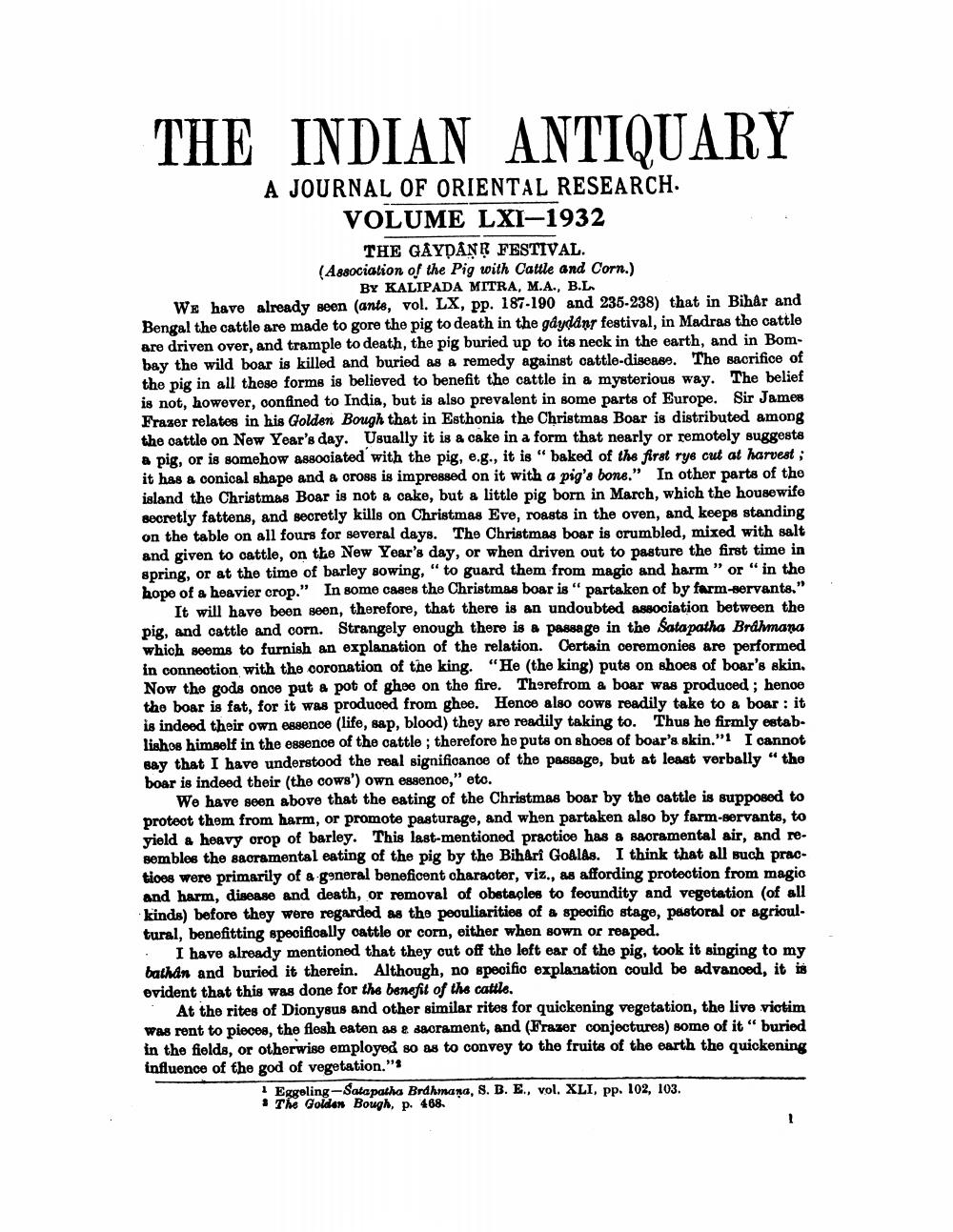Book Title: Indian Antiquary Vol 61 Author(s): Richard Carnac Temple, Charles E A W Oldham, S Krishnaswami Aiyangar, Devadatta Ramkrishna Bhandarka Publisher: Swati Publications View full book textPage 7
________________ THE INDIAN ANTIQUARY A JOURNAL OF ORIENTAL RESEARCH. VOLUME LXI-1932 THE GAYDÁNR FESTIVAL. (Association of the Pig with Cattle and Corn.) BY KALIPADA MITRA, M.A., B.L. We have already seen (anto, vol. LX, pp. 187-190 and 235-238) that in Bihar and Bengal the cattle are made to gore the pig to death in the gdydány festival, in Madras the cattle are driven over, and trample to death, the pig buried up to its neck in the earth, and in Bombay the wild boar is killed and buried as a remedy against cattle-disease. The sacrifice of the pig in all these forme is believed to benefit the cattle in a mysterious way. The belief is not, however, confined to India, but is also prevalent in some parts of Europe. Sir James Fraser relates in his Golden Bough that in Esthonia the Christmas Boar is distributed among the oattle on New Year's day. Usually it is & cake in a form that nearly or remotely suggests a pig, or is somehow associated with the pig, e.g., it is " baked of the first rye cut at harvest; it has a conical shape and a cross is impressed on it with a pig'a bone." In other parts of the island the Christmas Boar is not a cake, but a little pig born in March, which the housewife secretly fattens, and secretly kills on Christmas Eve, roasts in the oven, and keeps standing on the table on all fours for several days. The Christmas boar is orumbled, mixed with salt and given to cattle, on the New Year's day, or when driven out to pasture the first time in spring, or at the time of barley sowing, “to guard them from magic and harm" or " in the kope of a heavier crop." In some cases the Christmas boar is" partaken of by farm-Hervants." It will have boon seen, therefore, that there is an undoubted association between the pig, and cattle and corn. Strangely enough there is a passage in the Sata patha Brahmana which seems to furnish an explanation of the relation. Certain ceremonies are performed in conneotion with the coronation of the king. “He (the king) puts on shoes of boar's skin. Now the gods onoe put a pot of ghee on the fire. Therefrom a boar was produced; henoe the boar is fat, for it was produced from ghee. Hence also cows readily take to a boar : it is indeed their own essence (life, sap, blood) they are readily taking to. Thus he firmly establishos himself in the essence of the cattle; therefore he puts on shoes of boar's skin."1 I cannot say that I have understood the real significance of the passage, but at least verbally " the boar is indeed their (the cows') own essence," etc. We have seen above that the eating of the Christmas boar by the cattle is supposed to proteot them from harm, or promote pasturage, and when partaken also by farm-servants, to yield a heavy crop of barley. This last-mentioned practice has a sacramental air, and resembles the sacramental eating of the pig by the Bihari Goalas. I think that all such practions were primarily of a general beneficent character, viz., as affording protection from magic and harm, disease and death, or removal of obstacles to fecundity and vegetation (of all kinds) before they were regarded as the peouliarities of a specifio stage, pastoral or agricul. tural, benefitting specifically cattle or corn, either when sown or reaped. • I have already mentioned that they cut off the left ear of the pig, took it singing to my bathan and buried it therein. Although, no specific explanation could be advanced, it is evident that this was done for the benefit of the cattle. At the rites of Dionysus and other similar rites for quickening vegetation, the live victim was rent to pieces, the flesh eaten as e sacrament, and (Frazer conjectures) some of it “ buried in the fields, or otherwise employed so as to convey to the fruits of the earth the quickening influence of the god of vegetation." 1 Eggoling-Satapatha Brdhmana, S. B. E., vol. XLI, pp. 102, 103. : The Golden Bough, p. 468Page Navigation
1 ... 5 6 7 8 9 10 11 12 13 14 15 16 17 18 19 20 21 22 23 24 25 26 27 28 29 30 31 32 33 34 35 36 37 38 39 40 41 42 43 44 45 46 47 48 49 50 51 52 53 54 55 56 57 58 59 60 61 62 63 64 65 66 67 68 69 70 71 72 ... 428
